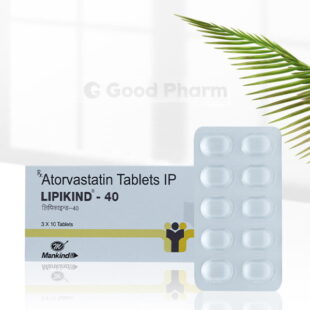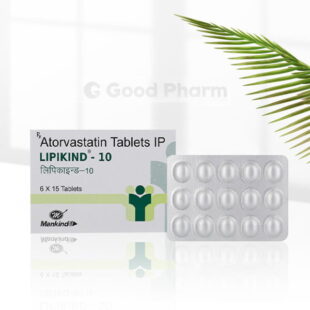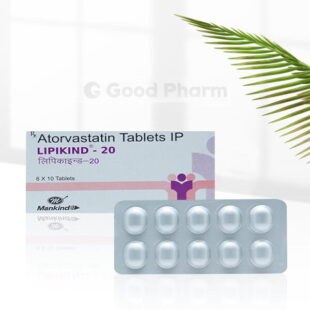- Your cart is empty
- Continue Shopping
Atorvastatin (Tonact) 10mg is a generic brand name of its active ingredient, Atorvastatin. This drug is an oral prescription medicine. It is an FDA approved drug used to prevent primary and secondary cardiovascular events in patients with cardiac risk factors and patients with abnormal lipid profiles in combination with dietary modifications.
What does Atorvastatin (Tonact) 10mg contain?
Tonact 10mg, contains an active ingredient, atorvastatin which is a lipid lowering medications called HMG-CoA reductase inhibitors or statins.
How does Atorvastatin (Tonact) 10mg work?
This medicine works by lowering LDL cholesterol by slowing down the liver’s production of cholesterol. They also increase the liver’s ability to remove LDL cholesterol that is already in the blood. As a result, it reduces “bad” cholesterol (LDL) and triglycerides while increasing “good” cholesterol levels (HDL).
Who cannot take Atorvastatin (Tonact) 10mg?
Atorvastatin is not suitable for everyone. Before taking this drug, inform your doctor if you have any of the following conditions. Patients under treatment for the following conditions or any ongoing managed condition should consult their doctor prior to taking this medication.
- You should not use this medicine if you are allergic to atorvastatin or any other medicine
- Patients with liver and kidney problems (or if you are on dialysis)
- Patient who might be pregnant, are already pregnant, or you’re breastfeeding
- Patients who have lung disease
- Patients who have previously had a stroke caused by bleeding into the brain
- Patients who regularly drink large amounts of alcohol
- Patient with an underactive thyroid
- Patients who have had muscular side effects when taking a statins in the past
- Patients who have ever had a muscle disorder (including fibromyalgia)
- Lipitor chewable tablets contain something called aspartame. Check with your doctor before taking these if you have phenylketonuria (a rare inherited disorder of protein metabolism).
How should you take Atorvastatin (Tonact) 10mg?
Atorvastatin (Tonact) 10mg comes as a tablet to be taken by mouth. You may view Additional Information tab for recommended doses. It is usually taken once a day with or without food. Take atorvastatin at around the same time every day. Follow the directions on your prescription label carefully.
Avoid excessive consumption (>1 L/day) of grapefruit juice. Do not take this medicine in larger or smaller amounts or for longer than recommended. Do not skip any doses and finish the full course of treatment.
The number of doses you take each day, the time allowed between doses, and the length of time you take the medicine depend on the medical problem for which you are using this medicine.
Indications and Dosage:
Heterozygous Familial Hypercholesterolaemia
Child: Dose is individualized according to baseline LDL-C levels, the goal of therapy, and patient response. As an adjunct to diet: 10-17 years. Initially, 10 mg daily; may be adjusted according to response at intervals of at least 4 weeks. Usual range: 10-20 mg once daily.
Mixed Dyslipidemia, Primary Hypercholesterolemia
Adult: Dose is individualized according to baseline LDL-cholesterol (LDL-C) levels, the goal of therapy, and patient response. As an adjunct to diet: Usual initial dose: 10 mg or 20 mg once daily; patients who require >45% reduction in LDL-C may initiate at 40 mg once daily. Usual range: 10-80 mg once daily. Max: 80 mg once daily. Evaluate lipid levels within 2-4 weeks after initiation and/or upon titration, then adjust dose accordingly.
Homozygous Familial Hypercholesterolemia
Adult: Dose is individualized according to baseline LDL-C levels, the goal of therapy, and patient response. As an adjunct to other lipid-lowering treatments (e.g. LDL apheresis): 10-80 mg daily.
Prophylaxis of cardiovascular events in high-risk patients
Adult: Dose is individualized according to baseline LDL-C levels, the goal of therapy, and patient response. Primary prevention: Initially, 10 mg daily. Higher doses may be required to attain LDL-C levels according to current guidelines.
Periodically reassess the appropriateness of continued use of the daily regimen. Dosage recommendations may vary among individual products and between countries (refer to detailed product guideline).
What if you miss a dose?
If you miss a dose of this medicine, take it as soon as possible. However, if it is almost time for your next dose, skip the missed dose and go back to your regular dosing schedule.
Do not double the doses.
What if you take too much?
If you take too much of the drug, seek medical help immediately.
What are the side effects of Atorvastatin (Tonact) 10mg?
Most side effects do not require any medical attention and disappear as your body adjusts to the medicine. The most frequently reported adverse effect by patient taking atorvastatin include:
- Joint pain
- Stuffy nose
- Sore throat
- Diarrhea
- Pain in your arms or legs
This is not a complete list of possible adverse effects; others may arise. For medical advice on side effects, contact your doctor.
Get emergency medical help if you have signs of an allergic reaction (hives, difficulty of breathing, swelling in your face of throat) to atorvastatin, or a severe skin reaction (fever, sore throat, burning in your eyes, skin pain, red or purple skin rash that spreads and causes blistering and peeling).
In rare cases, atorvastatin can cause a condition that results in the breakdown of skeletal muscle tissue, potentially leading to kidney failure. Call your doctor right away if you have unexplained muscle pain, tenderness, or weakness especially if you also have fever, unusual tiredness, and dark colored urine.
What other precautions should be taken?
Children
Most statin drugs are FDA-approved for children and teens under age 18 but only if they have a genetic condition that causes extremely high levels of LDL (bad) cholesterol. Yet in 2009, pediatricians wrote children in the U.S. at least 2.8 million prescriptions for drugs to lower cholesterol, nearly 2.3 million of them were for statins (not including prescriptions written by family doctors, psychiatrists, and other pediatric specialists), according to an internal analysis of prescription data.
Elderly
Statins should be prescribed with caution in elderly individuals, who may present more frequent side effects of the treatment than younger people because of the multiple associated comorbidities and drug interactions. In conclusion, despite the possible side effects of the therapy, elderly patients should receive statins to avoid a cardiovascular event, such as myocardial infarction or stroke. Prevention of a first or recurrent cardiovascular event is the most important goal of statin therapy, which may considerably improve morbidity and mortality in older people.
Pregnancy
The US Food and Drug Administration currently designate statins in pregnancy as category X or contraindicated. Statins in pregnancy are also contraindicated in Europe and in many other countries worldwide. The FDA declared that the benefits of taking them do not outweigh potential risks.
Breastfeeding
This drug is distributed in breast milk. It is contraindicated during pregnancy and may produce skeletal malformation.
Drug-Disease interactions
There are 5 disease interactions with atorvastatin which include:
-
- Liver disease: Major Potential Hazard, High plausibility. Applicable conditions: Alcoholism
- Rhabdomyolysis: Major Potential Hazard, Moderate plausibility. Applicable conditions: Myopathy, Myoneural Disorder, Hypothyroidism, Renal Dysfunction
- Cognitive impairment: Moderate Potential Hazard, Moderate plausibility. Applicable conditions: CNS Disorder
- Diabetes: Moderate Potential Hazard, Moderate plausibility. Applicable conditions: Diabetes Mellitus
- Renal disease: Moderate Potential Hazard, Moderate plausibility. Applicable conditions: Renal Dysfunction
Before taking this drug, inform your doctor if you have any of the following conditions.
Drug-drug interactions
Patients under treatment for the following conditions, or any ongoing managed condition, should consult their doctor prior to taking this medication
-
- May increase the risk of myopathy (muscle problems) and rhabdomyolysis (breakdown of skeletal muscles): Clarithromycin, erythromycin, ketoconazole, voriconazole, itraconazole, posaconazole, diltiazem, verapamil, certain antivirals for hepatitis C, HIV protease inhibitors, transport protein inhibitors (e.g. letermovir), gemfibrozil or other fibric acid derivatives, niacin, ezetimibe, and colchicine.
- May reduce effectiveness of statins: Efavirenz, rifampicin, aluminum and magnesium-containing antacid, colestipol, and St. John’s wort
- May potentiate effects of digoxin, norethisterone and ethinylestradiol
- Potentially Fatal: Concomitant use with systemic fusidic acid may significantly increase the risk for muscle toxicities, including rhabdomyolysis. Increased concentrations in the blood with glecaprevir/pibrentasvir, telaprevir, ciclosporin, and tipranavir/ritonavir, increasing the risk of myopathy or rhabdomyolysis.
Alcohol
Atorvastatin may cause liver problems, and using it with substantial quantities of ethanol may increase that risk. You should limit or avoid the use of alcohol while being treated with these medications.
Driving
Atorvaststin is not expected to affect your ability to drive a car or operate machinery. If you experience a decrease in alertness, dizziness, sleepiness, or changes in vision, do not drive and immediately consult your doctor.
Diet and lifestyle
Lifestyle changes that can reduce your cholesterol level and cardiovascular disease risk include: eating a healthy, balanced diet. exercising regularly, maintaining a healthy weight.
Avoid taking grapefruit juice while on treatment as it may increase concentration of statins in the blood.
How should you store Atorvastatin (Tonact) 10mg?
Store the medicine in a closed container at room temperature, away from heat, moisture, and direct light.
Keep from freezing.
Keep out of the reach of children.
Do not keep outdated medicine or medicine no longer needed.
Quick Tips
- Avoid eating foods that are high in fat or cholesterol. Atorvastatin will not be as effective in lowering your cholesterol if you do not follow a cholesterol-lowering diet plan.
- Minimize drinking alcohol. It can raise triglyceride levels and may increase your risk of liver damage.
- Grapefruit and grapefruit juice may interact with atorvastatin and lead to potentially dangerous effects. Avoid drinking more than 1 liter per day of grapefruit juice while taking this medicine.
What company produces Atorvastatin (Tonact) 10mg?
| Lupin | CEO: Vinita D. Gupta Founder: Desh Bandhu Gupta Founded: 1968 Headquarters: Western Expressway Highway, Santacruz (East), Mumbai 400 055, India. Number of employees: 18,686 Subsidiaries: Lupin Ltd Subsidiaries Website: lupin.com |
Additional Information
| Dosage | The dose of this medicine will be different for different patients. Follow your doctor's orders or the directions on the label. Recommended doses are as follows. If your dose is different, do not change it unless your doctor tells you to do so. Heterozygous Familial Hypercholesterolemia: Child: Dose is individualized according to baseline LDL-C levels, the goal of therapy, and patient response. As an adjunct to diet: 10-17 years. Initially, 10 mg daily; may be adjusted according to response at intervals of at least 4 weeks. Usual range: 10-20 mg once daily. Mixed Dyslipidemia, Primary Hypercholesterolemia: Adult: Dose is individualized according to baseline LDL-cholesterol (LDL-C) levels, the goal of therapy, and patient response. As an adjunct to diet: Usual initial dose: 10 mg or 20 mg once daily; patients who require >45% reduction in LDL-C may initiate at 40 mg once daily. Usual range: 10-80 mg once daily. Max: 80 mg once daily. Evaluate lipid levels within 2-4 weeks after initiation and/or upon titration, then adjust dose accordingly. Homozygous Familial Hypercholesterolemia: Adult: Dose is individualized according to baseline LDL-C levels, the goal of therapy, and patient response. As an adjunct to other lipid-lowering treatments (e.g. LDL apheresis): 10-80 mg daily. Prophylaxis of cardiovascular events in high-risk patients: Adult: Dose is individualized according to baseline LDL-C levels, the goal of therapy, and patient response. Primary prevention: Initially, 10 mg daily. Higher doses may be required to attain LDL-C levels according to current guidelines. |
|---|---|
| Side Effects | Common side effects: Rare but serious side effects: |
| Contraindications | – Active liver disease or unexplained persistent elevated liver function tests |
| Pack Size | 30 Pills, 60 Pills, 90 Pills |
Only logged in customers who have purchased this product may leave a review.











Reviews
There are no reviews yet.